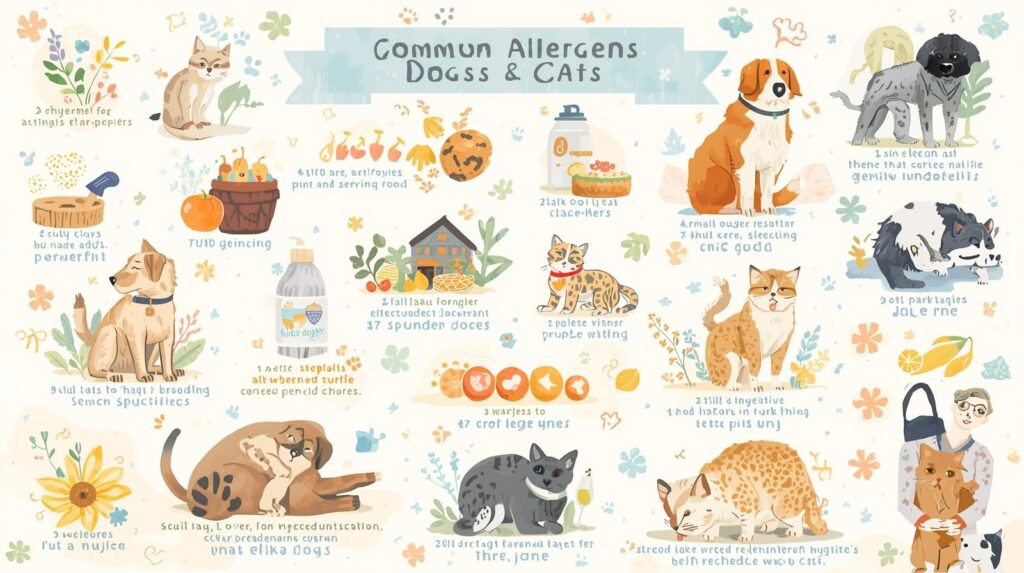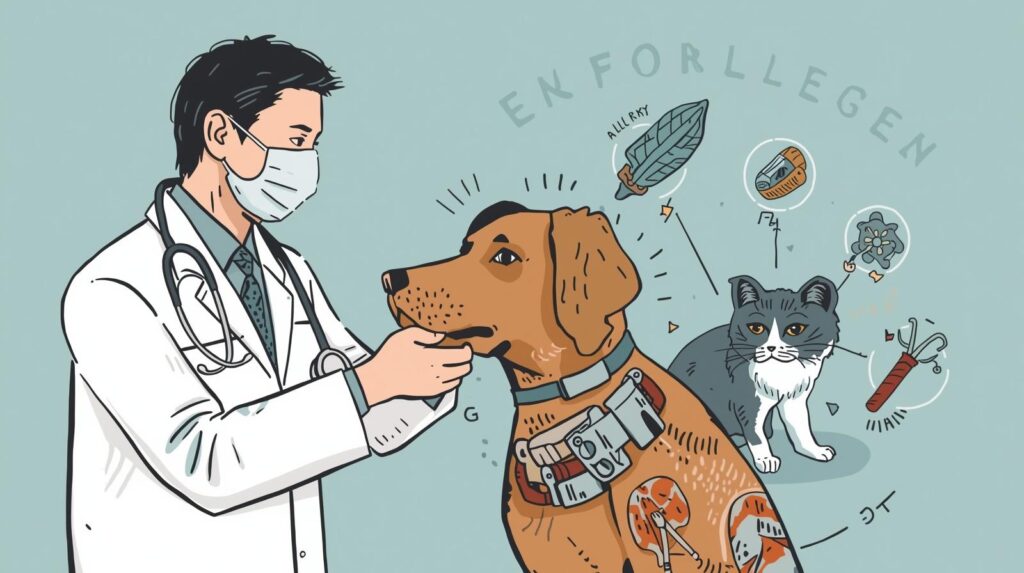Managing Common Allergies in Dogs and Cats
Hey, have you ever seen your pet scratching like crazy or sneezing non-stop? It’s tough to watch, right? I’ve been there with my dog, Max, who once had a rash that drove him nuts. Turns out, pets get allergies just like we do, and managing them is easier than you’d think with some know-how. Let’s chat about common allergies in dogs and cats, what causes them, and how to keep your furry buddy comfy.
Pet allergies are super common—about 20% of dogs and cats deal with them at some point. They’re not just annoying; they can make your pet miserable if ignored. But with the right steps, you can help them feel better fast. I’m sharing what I’ve learned from Max’s vet visits and some tricks that worked for my friend’s cat, too.
What Are Pet Allergies, Anyway?
Allergies happen when your pet’s immune system overreacts to something harmless, like pollen or food. Dogs and cats get three main types: flea allergies, environmental allergies (like pollen or dust), and food allergies. Each one shows up differently, but they all make your pet itchy or sick.
For example, Max gets red paws from grass pollen in spring. My neighbor’s cat, Luna, had a flea allergy that made her fur fall out. Knowing the type helps you tackle it. The best part? You don’t need a PhD to figure this out—just some observation and maybe a vet chat.
Spotting the Signs of Allergies
First, watch for clues. Itchy skin, red ears, or constant paw licking are big red flags. Dogs might chew their tails raw, while cats often over-groom, leaving bald spots. Sneezing, watery eyes, or tummy troubles like vomiting can also point to allergies.
I missed Max’s signs at first—thought he was just being dramatic. But when his scratching woke me up at 3 a.m., I knew something was up. Tip: Keep a quick note of when symptoms start. It helps your vet pinpoint the cause, like if it’s seasonal or food-related.
Flea Allergies: The Sneaky Culprit
Flea allergies are the top issue for both dogs and cats. One flea bite can make them itch for days! You’ll see hot spots—red, oozy patches—especially on their back or tail base. Cats might get tiny scabs all over.
My friend forgot to check Luna’s fur and ended up with a flea fiasco. Regular flea meds, like drops or collars, are your best defense. I use a monthly spot-on for Max; costs about $15 and saves us both grief. Pro tip: Wash bedding weekly and vacuum often to stop fleas from crashing the party.

Warning: Don’t skip treatments, even in winter. Fleas are sneaky year-round in warm climates. Also, check with your vet—some pets are sensitive to certain flea products.
Environmental Allergies: Nature’s Not Always Nice
Pollen, dust, or mold can make your pet itch like crazy. These are called atopic allergies, and they’re super common, especially in spring or fall. Dogs might get red bellies or ear infections; cats often sneeze or get watery eyes.
Max’s grass allergy had me wiping his paws after every walk. Sounds like a chore, but baby wipes did the trick. Vets might suggest antihistamines or special shampoos—$10 a bottle goes a long way. I also keep windows closed during pollen peaks to cut down on sneezes.
Real-life use: A quick rinse after outdoor playtime can stop flare-ups. If your pet’s symptoms scream “seasonal,” track pollen counts online. It’s like checking the weather for your dog’s comfort.
Common allergies in dogs and cats
Food Allergies: It’s What’s for Dinner
Food allergies are trickier. They’re less common—only about 10% of pet allergies—but can cause itching, ear infections, or upset stomachs. Common culprits? Chicken, beef, dairy, or grains. Cats might react to fish, too.
I switched Max to a limited-ingredient diet after his vet suspected chicken was the issue. Took a few weeks, but his ears stopped smelling funky. You might need a food trial—feeding one protein, like lamb, for 8–12 weeks. It’s a commitment, but worth it.
Tip: Read labels like a detective. Avoid “mystery meats” in cheap foods. FAQ: Can I just switch foods? Nope, gradual changes prevent tummy woes. Ask your vet for a plan.
Getting a Diagnosis: Start Smart
Wondering what’s bugging your pet? Start with a vet visit. They’ll ask about symptoms, check your pet’s skin, and maybe do tests. Skin scrapes rule out mites; blood tests can confirm food issues. Costs vary—$50 for a basic exam, up to $200 for fancy tests.
I skipped testing with Max at first, thinking I’d guess the cause. Big mistake—wasted time and money on wrong shampoos. Telehealth’s awesome here; I used an app to show Max’s rash, and the vet guided me without a car trip. Saves stress for both of you.
Warning: Don’t play Dr. Google too much. Random online advice can make things worse. Stick to licensed vets for solid answers.
Treatment Options: Relief Is Real
Good news—most allergies are manageable. For fleas, stick to preventives. Environmental allergies might need meds like Apoquel for dogs ($1–2 per pill) or steroids for quick relief. Cats often do well with antihistamines.
Bathing helps tons. Oatmeal shampoos soothe skin for about $12 a bottle. I bathe Max weekly during allergy season; he’s not thrilled, but it works. For food allergies, special diets like hydrolyzed protein foods are gold, though they’re pricier—$40 for a small bag.
Here’s a gem: Omega-3 supplements, like fish oil, reduce inflammation. I add a pump to Max’s food daily—$15 a month, and his coat’s shiny. Always check with your vet before starting meds or supplements.
Home Hacks for Allergy Relief
You don’t need to break the bank. Vacuum daily to zap dust and pollen. Use hypoallergenic bedding—machine-washable ones are around $20. For food allergies, cook plain rice and boiled chicken as a temp fix while sorting diets.
My friend swears by coconut oil for her cat’s dry skin—just a tiny dab. Air purifiers help, too; I got a small one for $50, and Max’s sneezing dropped. Keep it simple: Clean paws, clean house, happy pet.

Pro tip: Track flare-ups in a notebook or app. Patterns pop out, like “worse after park visits.” It’s like being a pet detective, and it saves vet bills.
Telehealth for Allergies: A Game-Changer
Remember how I mentioned telehealth? It’s perfect for allergies. Apps like Vetster or AirVet let you show rashes or ear gunk via video. A consult’s $20–$40, way cheaper than driving to a clinic. Vets can prescribe meds or guide food trials remotely.
I used one when Max’s ears got red again. The vet saw my video, sent drops to my pharmacy, and bam—fixed in days. It’s great for follow-ups or mild issues. But for tests or emergencies, you’ll still need an in-person visit.
FAQ: Is telehealth enough? For minor allergies or monitoring, yes. For complex cases, pair it with clinic trips.
Preventing Flare-Ups: Stay Ahead
Prevention’s better than a cure. Stick to flea meds year-round. For environmental allergies, wipe down paws and fur after outdoor time. Food allergies? Avoid table scraps—sorry, no pizza crust for Fido.
I learned the hard way with Max—gave him a treat with dairy, and his itching exploded. Now I keep a stash of hypoallergenic treats ($8 a bag). Also, regular grooming catches skin issues early. Brush your pet weekly; it’s bonding time, too.
Benefit: Fewer flare-ups mean less stress and lower costs. A $15 flea collar beats a $100 vet bill any day.
FAQs: Your Burning Questions
How do I know if it’s allergies or something else? Itching, red skin, or sneezing are clues, but vets confirm with exams or tests.
Can allergies go away? Some do, especially with food changes, but most need ongoing care.
Are over-the-counter meds safe? Sometimes, like Benadryl for dogs, but always ask your vet for doses.
What if my pet hates baths? Use pet wipes or dry shampoos—less fuss, same relief.
Can puppies or kittens have allergies? Yup, even young ones. Start tracking symptoms early.
Got more questions? Most telehealth apps have 24/7 chats for quick answers.
Wrapping It Up: Keep Your Pet Comfy
Allergies stink, but they don’t have to ruin your pet’s life—or yours. With simple steps like flea control, smart diets, and maybe a telehealth chat, you can keep your dog or cat happy. I’ve seen Max go from scratching maniac to chill cuddle buddy, and it feels amazing.
Start small: Check for fleas, note symptoms, and talk to a vet. You’ve got this, and your pet will thank you with extra tail wags or purrs. What’s the first step you’ll try?
